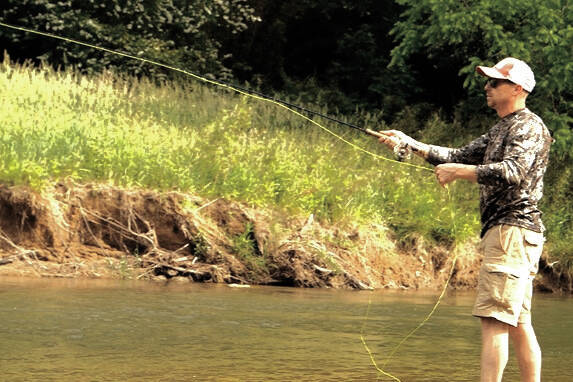RALEIGH — The N.C. Wildlife Resources Commission will implement Delayed Harvest Trout Waters regulations on 33 trout waters on Oct. 1.
Under Delayed Harvest Trout Waters regulations, no trout may be harvested or possessed from identified waters between Oct. 1 and one half-hour after sunset on June 1, 2024. No natural bait may be possessed, and anglers can fish only with artificial lures with one single hook. An artificial lure is defined as a fishing lure that neither contains nor has been treated with any substance that attracts fish by the sense of taste or smell.
Wildlife Commission staff stock Delayed Harvest Trout Waters from fall through spring with high densities of trout to increase anglers’ chances of catching fish. Delayed Harvest Trout Waters, posted with diamond-shaped, black-and-white signs, are popular fishing destinations for anglers who enjoy catch-and-release trout fishing.
While fishing, anglers should consider these best practices to help prevent the spread of aquatic nuisance species like gill lice, whirling disease and didymo:
– CLEAN equipment of all aquatic plants, animals and mud
– DRAIN water from boats, live wells and equipment
– DRY equipment thoroughly
– NEVER MOVE fish, plants or other organisms from one body of water to another
Aquatic Nuisance Species
An aquatic nuisance species is a nonnative species that has been introduced and is known to be causing ecological or economic harm. Not every nonnative aquatic species is a problem. Some don’t occur in great numbers or create significant ecological or economic harm; others have important commercial or recreational value.
North Carolina has abundant and diverse water resources. Protecting them is important to support the state’s unique biological attributes and growing population and economy. Nationally, economic loses attributed to ANS total billions of dollars annually.
A total of 75% of the ANS in North Carolina have been introduced from other areas of North America. Humans are the cause in nearly all introductions, either through unintentional or deliberate actions. Over 60% of ANS fish species in NC were introduced by intentional stocking or bait release. To protect native or legally established aquatic species from the potentially damaging effects of unauthorized stockings, the N.C. Wildlife Resources Commission requires anyone wishing to stock a public, inland fishing water in North Carolina with fish, mussels or crustaceans to obtain a stocking permit issued by the agency’s Inland Fisheries Division. Learn more about Fish Stocking Permits. Additional pathways include direct stockings from private aquaculture facilities into public waters, cultivated species cultivated species that escaped captivity, “hitchhiking” on recreational or commercial watercraft, and aquarium releases. Help Stop the Spread of Aquatic Nuisance Species
While there are more than 300 species of freshwater and marine plants, animals and pathogens currently in North Carolina, below are the ones anglers, boaters and outdoor enthusiasts are most likely to encounter. We urge everyone to know what they are, how to identify them, and how to prevent their spread. Whirling disease and gill lice are two aquatic nuisance species found in trout in western North Carolina, while didymo is a nuisance algae that has been seen in the Tuckasegee River in Jackson County. Hydrilla, an highly invasive aquatic plant, is found in freshwater lakes and ponds across the state. Learn more about each of these below:
– Didymo
– Gill Lice
– Hydrilla
– Whirling Disease
– Zebra Mussels
The N.C. Wildlife Resources Commission, along with other state and federal agencies, developed the N.C. Aquatic Nuisance Species Management Plan to improve the state’s ability to address aquatic invasive and aquatic nuisance species with the goal of preventing and controlling their introduction, spread, and negative impacts.
Source: North Carolina Wildlife Resources Commission









